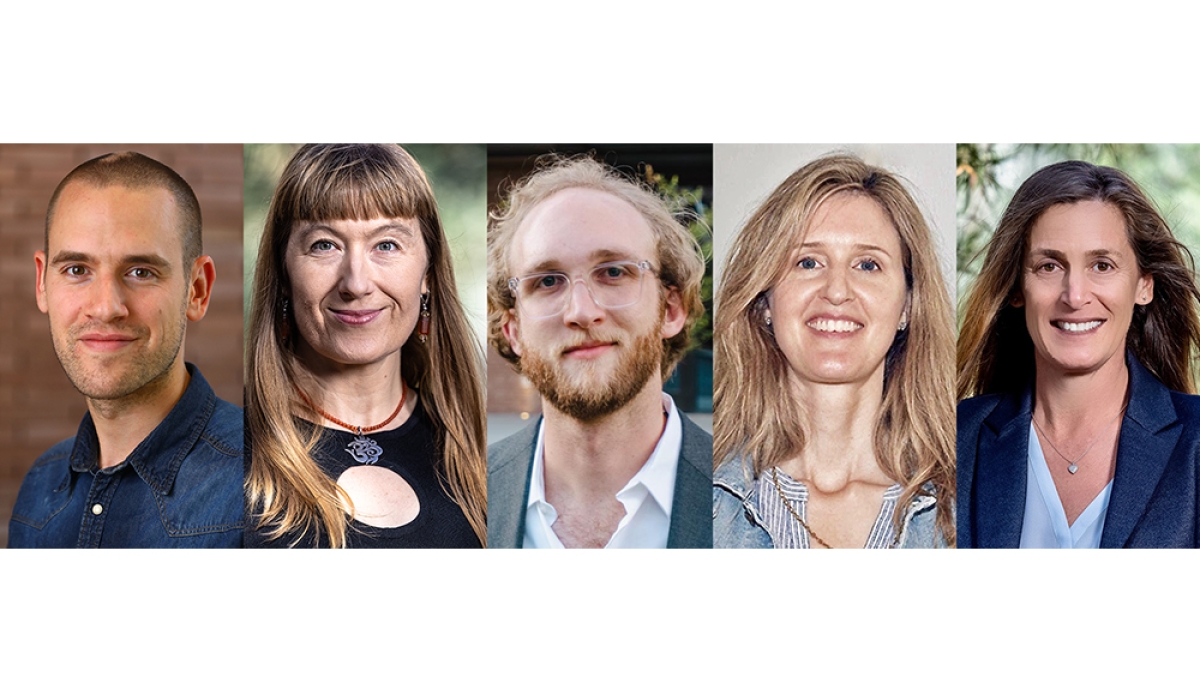ASU researchers call for universities to incentivize societally engaged conservation work

The authors of the recently published paper from the Center for Biodiversity Outcomes. From left to right: Simon Lhoest, Candice Carr Kelman, Chris Barton, Jessica Beaudette and Leah Gerber.
In the world of academia, a scientist’s list of publications is their currency: It helps them get job offers, promotions and research funding.
But publications don’t always make a difference outside of academia, as they may never reach members of the public who that research might be important to. That puts scientists in fields like conservation in the tough spot of choosing between doing work that boosts their career or work that makes a real-world difference.
A team of researchers from ASU’s Center for Biodiversity Outcomes argues that scientists shouldn’t be forced to make that choice. In their new paper published in the journal of Biological Conservation, the team calls upon universities to reward conservation scientists not only for their publications, but for doing work that has real outcomes.
“We want to make an impact with our work, and there’s only so much we can do writing peer-reviewed journal articles,” says Candice-Carr Kelman, one of the paper’s co-authors and the associate director of the Center for Biodiversity Outcomes. “I'm not saying it doesn't have an impact, it does. But if you are doing engaged work, you're seeing a difference being made. ... We want to see science be relevant again.”
Conservation science is done with one goal in mind: protecting the environment. But scientists can’t achieve that goal unless their work reaches the people who need it to make on-the-ground decisions, like policymakers, land managers or members of local communities.
While many conservation scientists already do work to connect with conservation practitioners and produce useful work, they must do it on their own time, since they won’t benefit from that work in a way that advances their career.
Simon Lhoest, the lead author on the paper, calls this “a loading dock problem, which is producing more and more scientific papers just assuming that conservation practitioners will pick it up and use it.
"In most cases, they don’t even have access to it.”
To think about how to fix that problem, the team conducted 71 interviews with conservation scientists doing engaged work, which revealed that most scientists feel universities need to make room for scholars to do engaged work.
The team came up with three specific recommendations for universities to do that: investing in work that spans the boundaries of academia; rewarding scholars who engage with non-academics to conduct their research; and creating new metrics for evaluating academics that values engaged scholarship as much as publications.
“In order for faculty to be interested in being a part of that (engaged work), there’s gotta be a reward system because the job is busy enough, right? We can’t be like ‘Oh, I think I’ll do this as a hobby,'” says Carr Kelman, who did much of the interview analysis work for this paper.
“We get a little stuck in antiquated systems of tenure and promotion and how we reward faculty. They could be broadened ... to include other forms of impactful work.”
Chris Barton, another co-author of the paper who recently graduated with his PhD from the School for the Future of Innovation in Society, explained that this paper particularly spoke to his own decision about whether to continue pursuing a career in academia.
“For people in my position ... our calling to do this work is not because we wanted to publish a bunch of papers," Barton says. "It’s because we wanted to have real impact in the world. So, you know, hopefully this paper ... helps make the academy a sort of place that those of us who signed up to do this work want to stick around in — and continue contributing to — long term.”
This paper is the sixth to come out of a NSF-funded collaborative project between the Center for Biodiversity Outcomes and the Center for Organization Research and Design. Many of their other publications have dealt with how to align the goals of conservation researchers and practitioners to produce actionable science.
Leah Gerber, the founding director of the Center for Biodiversity Outcomes, says she designed it “to be this boundary organization that achieves impact," but explains that there wasn't “a code for how to do that. There’s no standard method.”
So, she went ahead and “set up this experiment of creating this boundary organization to understand what works, so that other entities that want to achieve this can build on what we are learning.”
Hopefully, more institutions will follow the Center for Biodiversity Outcomes's lead to produce work with real impact. According to Lhoest, some universities are already doing so.
“We had amazing reactions (to the paper) from both ... ASU and the University of Liege in Belgium, where I am based now, telling us that they are already involved in all this and really open to change.
"I already had feedback from many other countries and many other institutions. Many people are really happy to engage in this direction.”
More Environment and sustainability

'Earth Day Amplified' promotes power of collective action
Everybody loves the concept of sustainability. They want to do their part, and the chance to say they’ve contributed to the well-being our of planet.But what does that actually mean?Arizona State…

Rethinking Water West conference explores sustainable solutions
How do you secure a future with clean, affordable water for fast-growing populations in places that are contending with unending drought, rising heat and a lot of outdated water supply infrastructure…
Meet the young students who designed an ocean-cleaning robot
A classroom in the middle of the Sonoran Desert might be the last place you’d expect to find ocean research — but that’s exactly what’s happening at Harvest Preparatory Academy in Yuma, Arizona.…

